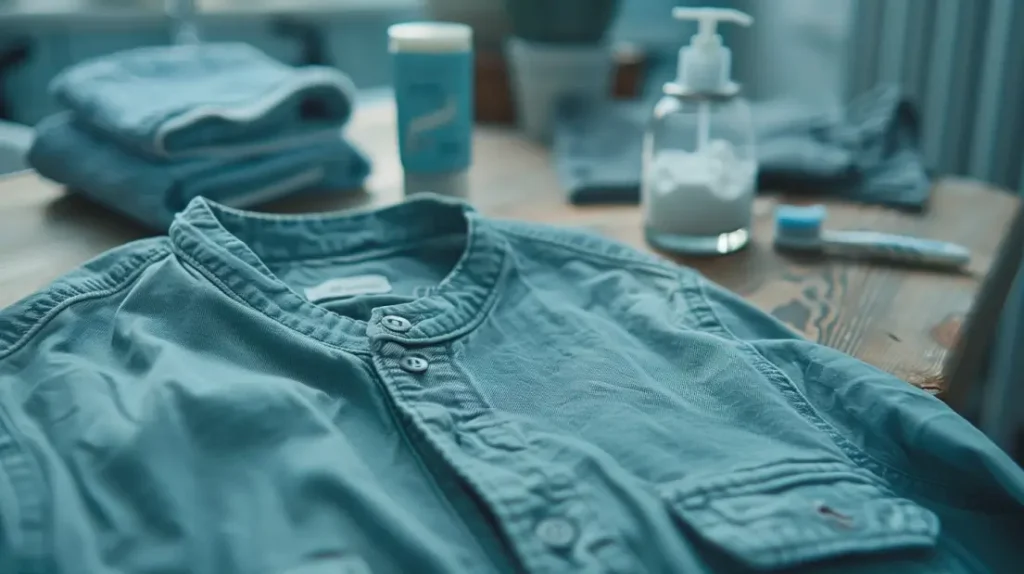Ever spilled coffee on your favorite shirt and wondered if there’s a quick fix? You might’ve heard that toothpaste can do more than just clean your teeth. But can it really tackle those pesky stains on your clothes?
In this article, you’ll discover whether toothpaste is a secret weapon for stain removal or just another myth. We’ll explore how it works, when to use it, and what types of stains it can handle. So next time you’re in a pinch, you’ll know exactly what to do.
Key Takeaways
- Effectiveness: Toothpaste can help remove certain types of stains from clothes, especially food stains like coffee, sauce, and berries, thanks to its mild abrasives and detergents.
- Ingredients: The combination of baking soda, silica, calcium carbonate, and detergents in toothpaste contributes to its stain-removing properties. Whitening toothpastes may also contain bleaching agents like hydrogen peroxide.
- Application: For best results, apply non-gel, white toothpaste directly on the stain, gently scrub, and let it sit for 10-15 minutes before rinsing and washing as usual.
- Fabric Safety: Always test toothpaste on an inconspicuous area of the fabric first to avoid damage or bleaching, especially on colored or delicate materials.
- Comparison with Traditional Methods: Toothpaste is a convenient, cost-effective option for minor stains but may not be as effective as specialized stain removers for tougher stains like grease and oil.
The Science Behind Toothpaste as a Stain Remover
You might wonder what makes toothpaste a candidate for stain removal on clothes. Toothpaste contains various ingredients that can help lift certain types of stains from fabrics.
Understanding the Ingredients
Toothpaste contains mild abrasives, such as baking soda, silica, and calcium carbonate. These components help scrub away stains on teeth, making them potentially useful on fabric as well. Baking soda, for example, is known for its ability to lift and neutralize stains. Silica acts as a gentle abrasive, helping to remove surface stains without damaging fabric.
Most toothpastes contain detergents like sodium lauryl sulfate. These detergents help break down oils and loosen particles, similar to how laundry detergents work. They emulsify and lift away grime, which may explain why some stains can be removed using toothpaste.
Bleaching agents, such as hydrogen peroxide, are found in some whitening toothpastes. Hydrogen peroxide is a common household cleaner and stain remover, making these types of toothpaste effective at tackling certain stains. However, it might not be safe for all fabrics or colors.
How Toothpaste Interacts with Fabric
Toothpaste’s abrasives scrub the fabric, potentially removing surface stains. The process involves applying a small amount of toothpaste directly onto the stain and lightly scrubbing with a toothbrush or cloth. This action helps lift the stain from the fibers.
The detergents in toothpaste break down and loosen the stain. By emulsifying oils and particles, the toothpaste can help make the stain more accessible to water during rinsing. This interaction mirrors how you treat stains with soap and water.
Hydrogen peroxide in whitening toothpastes can bleach stains. This can be particularly useful for white fabrics but might damage colored or delicate materials. Always test a small area first to avoid unexpected bleaching or fabric damage.
Toothpaste’s combination of mild abrasives, detergents, and possibly bleaching agents can make it a useful tool for tackling certain fabric stains, depending on the type and severity of the stain.
Different Types of Stains and Their Treatment
Using toothpaste to remove stains can be effective, depending on the stain. Different types of stains react differently to treatment methods.
Food Stains
Food stains, like those from coffee, sauce, or berries, are common. Applying toothpaste, which contains mild abrasives, can help break down the stain’s particles.
- Coffee Stains: Dab toothpaste directly on the stain. Gently scrub with a soft brush and rinse with cold water.
- Sauce Stains: Spread toothpaste over the stain. Let it sit for five minutes and then rinse.
- Berry Stains: Apply toothpaste, scrub lightly, and wash the fabric under cold water.
Toothpaste’s abrasive nature makes it suitable for these stains, but test it on a small area first if the fabric is delicate or colored.
Ink and Grease Stains
Ink and grease stains are challenging to remove. Toothpaste might help reduce their appearance but doesn’t guarantee complete removal.
- Ink Stains: Apply non-whitening toothpaste to the stain. Let it sit for ten minutes, then scrub gently and rinse. Repeat if necessary.
- Grease Stains: Spread toothpaste on the stain. Let it absorb the grease for several minutes, then rinse with warm water.
For both ink and grease stains, reapply toothpaste and repeat the process if the stain persists. Use caution with colored fabrics as some whitening toothpastes have bleaching agents.
Step-by-Step Guide to Removing Stains with Toothpaste
Toothpaste can be an effective solution for certain stains on clothes, but proper application is key. Follow this guide to get the best results.
Preparing the Stained Cloth
- Identify the Stain: Determine the type of stain (e.g., food, ink, grease) to decide the appropriate approach.
- Test the Fabric: Apply a small amount of toothpaste on an inconspicuous part of the fabric first. This ensures the toothpaste doesn’t damage or bleach the material.
- Blot Instead of Rub: Gently blot the stain with a clean cloth to remove any excess substance. Avoid rubbing as it can spread the stain.
Applying Toothpaste Effectively
- Choose the Right Toothpaste: Use a non-gel, white toothpaste without added colors or whitening agents to avoid potential bleaching effects.
- Apply a Small Amount: Squeeze a small amount of toothpaste directly onto the stain.
- Gently Work It In: Use a toothbrush or your fingers to gently work the toothpaste into the fabric. This helps the abrasive particles in the toothpaste break down the stain.
- Let It Sit: Allow the toothpaste to sit on the stain for 10-15 minutes. This gives it time to penetrate and break down the stain particles.
- Rinse Thoroughly: Rinse the treated area under cold running water to remove the toothpaste and loosened stain particles.
- Launder as Usual: Wash the garment according to the care label instructions. Use the regular detergent for the fabric type.
- Check Before Drying: Inspect the stained area after washing. If the stain persists, repeat the toothpaste treatment before drying, as heat from the dryer can set the stain permanently.
- Air Dry When Possible: Air dry the garment to avoid any potential damage from the dryer if the stain isn’t fully gone.
By following these steps, you can effectively use toothpaste to tackle stains on clothes.
Comparing Toothpaste with Other Stain Removers
Toothpaste can help remove stains from clothes, but it’s important to see how it stacks up against traditional stain removers.
Effectiveness on Various Stains
Toothpaste works well on certain stains like ink and makeup due to its mild abrasives and detergents. However, toothpaste isn’t as effective on grease or oil stains compared to dedicated stain removers.
Stain Types:
- Ink: Toothpaste can break down ink molecules, making it a decent option for pen marks.
- Makeup: The detergents in toothpaste can lift makeup stains.
- Grease: Specialized stain removers are better for tackling oil and grease stains, which are tough for toothpaste to break down.
Refer to the table for a quick comparison:
| Stain Type | Toothpaste Effectiveness | Traditional Stain Remover Effectiveness |
|---|---|---|
| Ink | Moderate | High |
| Makeup | Moderate | High |
| Grease | Low | High |
Cost and Availability
Toothpaste is generally cheap and readily available. Most households already have it, making it a convenient choice. Specialized stain removers, while often more effective, can be more expensive and not as readily available in every home.
Cost Comparison:
- Toothpaste: Typically costs between $1-$3 per tube and serves multiple purposes.
- Stain Removers: Usually range from $5-$10 per bottle, focusing solely on stain removal.
- Toothpaste: Found in nearly every home and available at all grocery and drug stores.
- Stain Removers: May need a specific shopping trip if not already at home.
Using toothpaste offers a quick, cost-effective option, although dedicated stain removers often provide superior results for difficult stains.
Conclusion
Toothpaste can be a handy, budget-friendly option for tackling minor stains on your clothes. Its mild abrasives and detergents can help with certain types of stains like ink and makeup. However, be cautious with delicate or colored fabrics to avoid any bleaching mishaps.
While it’s a convenient solution you probably already have at home it may not be the best for tough stains like grease or oil. For those stubborn spots specialized stain removers are your best bet. So next time you’re in a pinch give toothpaste a try but keep those dedicated stain removers on hand for the heavy-duty jobs.
Frequently Asked Questions
Can toothpaste remove all types of stains from clothes?
Toothpaste can be moderately effective on ink and makeup stains but is less effective on grease or oil stains. Specialized stain removers are recommended for tough stains.
Is it safe to use toothpaste on all fabrics?
Caution is needed with colored or delicate fabrics, as toothpaste can have bleaching effects and may damage the material.
How do I use toothpaste to remove stains?
Apply a small amount of toothpaste to the stain, gently rub with a cloth or brush, rinse with water, and then wash as usual.
How does toothpaste compare to traditional stain removers in terms of cost?
Toothpaste is generally cheaper and more convenient, as it is commonly found in most households, making it a budget-friendly option.
Are specialized stain removers more effective than toothpaste?
Yes, specialized stain removers tend to be more effective, especially on difficult stains like grease and oil, providing superior results compared to toothpaste.
What ingredients in toothpaste help remove stains?
Toothpaste contains mild abrasives and detergents that help break down and lift stains from fabric.
Can toothpaste bleach clothes?
Yes, toothpaste can potentially bleach or discolor clothes, particularly colored or delicate fabrics; proceed with caution and test on a small area first.
Is toothpaste a good alternative for quick stain removal?
Toothpaste offers a quick and cost-effective solution for minor stains but is not a substitute for dedicated stain removers for tough stains.
How does toothpaste perform on ink and makeup stains?
Toothpaste is found to be moderately effective in removing ink and makeup stains but may not completely eliminate them.
Does the type of toothpaste matter in stain removal?
While most toothpaste types have cleaning properties, those with whitening agents or strong abrasives might be more effective but also riskier for fabric damage.



